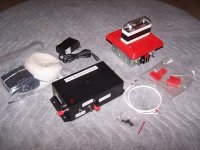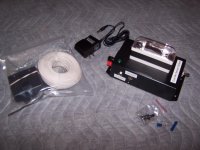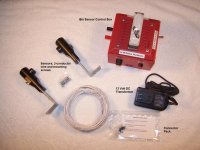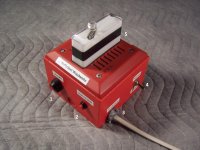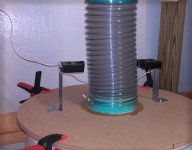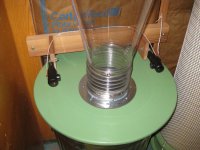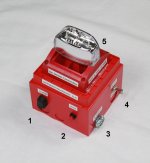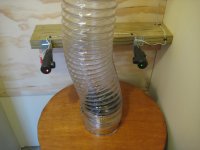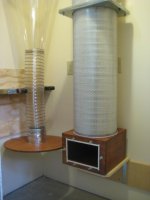I finally was able to install my ClearVue 1800 (purchased almost 2 years ago...) After reading about the issues of letting the barrel overfill and dump sawdust into the filters - I decided to be proactive and install a bin sensor when I installed the cyclone. I had seen a number of bin sensor setups, and was going to cobble together one of McRabbet's designs when I saw he was offering a kit. The kit had all the design features I wanted, and I did not have to go dig up, or substitute parts. And the cost was very reasonable - just a little more than the parts. Looked like a Win-Win for me, so I ordered one.
The parts arrived well packaged and complete. I sorted thru everything, read the instructions, and was ready for the install - almost. I still had to make a top for my 55 gal barrel and wire a wall switch to turn on the cyclone. The one thing I could do was mount the strobe/horn alarm. I have a large shop (see my install pics in the gallery) and I wanted to mount the alarm overhead in the middle of the shop for good coverage. This placed the alarm about 40 feet from where the control box would be located (in the noise room with the cyclone). The kit contained 100 feet of speaker wire for remote locations, so I did not have to get my own. I was a little concerned about the small size of the wire running that far, but Rob assured me it would work fine. I took the ends of the wire to connect to the alarm and found out is is much easier to attach the wires before mounting the alarm flush to the surface. The screws sit close to the rear of the unit, so I had to work a little to slide the connectors under screw heads - but it was not a big deal, just would have been easier to attach before mounting.
A couple weekends later, I had the cyclone running and was ready to install the sensor kit. Per the instructions, I ran the wire from the alarm to the controller box, installed the wiring from controller box to relay box (8x8 pvc box from Lowes), mounted the sensors to the bin lid, and connected the sensor wires. I plugged up the 12 volt supply that was in the kit, flipped the toggle switch, the red light on the control box lit up, and I was ready for testing. It was harder to run the 110 light circuit and the wall switch - than it was to install the controller.
I called over the LOML, and flipped the wall switch to start the cyclone.
and
everything worked as designed . The cyclone ran great. If I blocked the sensors for ~10 sec, the alarm light and horn sounded and shut down the cyclone. If I switched the bypass, after 10 sec, the alarm went off - but the cyclone continued. If I turned the bin sensor controller off, the cyclone worked normally with the on/off switch on the wall.
. The cyclone ran great. If I blocked the sensors for ~10 sec, the alarm light and horn sounded and shut down the cyclone. If I switched the bypass, after 10 sec, the alarm went off - but the cyclone continued. If I turned the bin sensor controller off, the cyclone worked normally with the on/off switch on the wall.
Since the initial test, I have run the table saw, chop saw with no issues. The alarm did go off when I was planning a long board. I watched the sawdust streaming thru the flex pipe when the planer was running, and it was very thick - no way the sensors could see thru it. The long board sent sawdust thru and blocked the sensors for more than 10 sec, so they did their job perfectly. Since I knew the bin was only half full, I bypassed the alarm while planing. I even remembered to switch back after planing...at least I think I did...
Ok, Ok, I gotta find some improvement suggestion for the kit. The kit is really good, so it is difficult to find any faults. I guess FREE would be an improvement, but not realistic.
The only thing I can come up with is that the controller box screws are installed from the rear. Once you mount the unit to the wall - you cannot disassemble the box to make any adjustments or repairs (it is possible to forget to slide on a connector before you close up the box - ). So, a box that could be opened from the front would allow corrections without having to remove the unit from the wall.
). So, a box that could be opened from the front would allow corrections without having to remove the unit from the wall.
I am pleased and happy with my cyclone and McRabbet's full bin sensor kit. It is a simple set up, and the kit has most everything needed for installation at a great price.
I would recommend this to anyone who wants a good solution without having to spend time putting something together on their own.
It is great to have a forum like this where we can help each other to make the best use of our time.
The parts arrived well packaged and complete. I sorted thru everything, read the instructions, and was ready for the install - almost. I still had to make a top for my 55 gal barrel and wire a wall switch to turn on the cyclone. The one thing I could do was mount the strobe/horn alarm. I have a large shop (see my install pics in the gallery) and I wanted to mount the alarm overhead in the middle of the shop for good coverage. This placed the alarm about 40 feet from where the control box would be located (in the noise room with the cyclone). The kit contained 100 feet of speaker wire for remote locations, so I did not have to get my own. I was a little concerned about the small size of the wire running that far, but Rob assured me it would work fine. I took the ends of the wire to connect to the alarm and found out is is much easier to attach the wires before mounting the alarm flush to the surface. The screws sit close to the rear of the unit, so I had to work a little to slide the connectors under screw heads - but it was not a big deal, just would have been easier to attach before mounting.
A couple weekends later, I had the cyclone running and was ready to install the sensor kit. Per the instructions, I ran the wire from the alarm to the controller box, installed the wiring from controller box to relay box (8x8 pvc box from Lowes), mounted the sensors to the bin lid, and connected the sensor wires. I plugged up the 12 volt supply that was in the kit, flipped the toggle switch, the red light on the control box lit up, and I was ready for testing. It was harder to run the 110 light circuit and the wall switch - than it was to install the controller.
I called over the LOML, and flipped the wall switch to start the cyclone.
and
everything worked as designed
Since the initial test, I have run the table saw, chop saw with no issues. The alarm did go off when I was planning a long board. I watched the sawdust streaming thru the flex pipe when the planer was running, and it was very thick - no way the sensors could see thru it. The long board sent sawdust thru and blocked the sensors for more than 10 sec, so they did their job perfectly. Since I knew the bin was only half full, I bypassed the alarm while planing. I even remembered to switch back after planing...at least I think I did...
Ok, Ok, I gotta find some improvement suggestion for the kit. The kit is really good, so it is difficult to find any faults. I guess FREE would be an improvement, but not realistic.
The only thing I can come up with is that the controller box screws are installed from the rear. Once you mount the unit to the wall - you cannot disassemble the box to make any adjustments or repairs (it is possible to forget to slide on a connector before you close up the box -
I am pleased and happy with my cyclone and McRabbet's full bin sensor kit. It is a simple set up, and the kit has most everything needed for installation at a great price.
I would recommend this to anyone who wants a good solution without having to spend time putting something together on their own.
It is great to have a forum like this where we can help each other to make the best use of our time.

